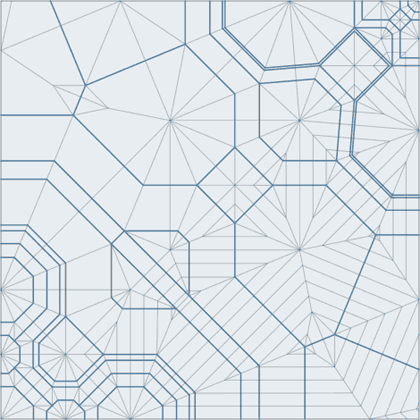Folding under pressure (that’s an old origami joke)
Susan Orlean has been AWOL from the pages of the New Yorker for some time now, but she’s back this week with a piece on origami and Robert Lang, former physicist and an acknowledged master of the craft.
He would have liked to have folded insects, but, in those years, bugs, as well as crustaceans, were still an origami impossibility. This was because no one had yet solved the problem of how to fold paper into figures with fat bodies and skinny appendages, so that most origami figures, even television characters and heads of state, still had the same basic shape as the paper cranes of nineteenth-century Japan. Then a few people around the globe had the idea that paper folding, besides being a pleasant diversion, might also have properties that could be analyzed and codified. Some started to study paper folding mathematically; others, including Lang, began devising mathematical tools to help with designing, all of which enabled the development of increasingly complex folding techniques. In 1970, no one could figure out how to make a credible-looking origami spider, but soon folders could make not just spiders but spiders of any species, with any length of leg, and cicadas with wings, and sawyer beetles with horns. For centuries, origami patterns had at most thirty steps; now they could have hundreds. And as origami became more complex it also became more practical. Scientists began applying these folding techniques to anything — medical, electrical, optical, or nanotechnical devices, and even to strands of DNA — that had a fixed size and shape but needed to be packed tightly and in an orderly way.
Lang’s creations are truly astounding, almost to the point of being magical, because the comparison of the finished product to a flat, uncut sheet of paper is so dissonant. Here are two views of one of Lang’s signature “bugs”, a 7” silverfish he folded in 2004. The folding pattern is followed by the completed product:


In 1987, Lang folded a 15” long cuckoo clock out of a single sheet of paper. The clock, which “made Lang a sensation in the origami world”, took him three months to design and six hours to fold. These days, he uses a computer program he wrote called TreeMaker to design his creations and a laser cutter borrowed from Squid Labs to gently score the paper for quicker & easier folding.
Squid Labs is responsible for a site called Instructables, which allows people to share step-by-step instructions for how to do just about anything, from broiled peanut butter and jelly sandwiches to origami. Lang doesn’t seem to have any instructions for his designs up on Instructables, but he shares the site’s open source and collaborative spirit…crease patterns for many of his most complex creations are available on his site and TreeMaker and ReferenceFinder are free to download (with the source code released under the GPL).
(Speaking of Instructables, here’s an easy way to get started with origami. Just grab that stack of Post-It Notes sitting on your desk (the square ones, not the letterbox ones), peel the top one off, and follow these simple instructions to make a little box out of it. It’ll take you 5 minutes…here’s mine that I did this morning.)
For more on Robert Lang and origami, check out his web site (don’t miss the foldable space telescope he’s helping to build at the Lawrence Livermore National Laboratory), an audio recording of Lang’s presentation from O’Reilly Media Open Source Conference 2005, an audio interview on The Connection, an interview with Cabinet magazine in 2005, and a more technical article by Lang on the mathematics and geometry of origami.
(As an aside, Lang’s physics background and current vocation reminded me of Richard Feynman and his interest in flexagons, which are basically geometric origami shapes that can flexed into different shapes. A colleague of Feynman’s invented the flexagon, which led to the formation of the Princeton Flexagon Committee, of which Feynman was a founding member.)





Reader comments
ChrisFeb 15, 2007 at 10:29AM
Lang's book is a great introduction to Origami. It has a comprehensive description of his folding techniques, and includes some of his most famous models (including the cuckoo clock).
ooFeb 15, 2007 at 10:38AM
Be sure to check out another amazing talent, Joseph Wu.
http://www.josephwu.com
BenFeb 15, 2007 at 12:39PM
Take a look at this.
It's a phoenix. It took 1361 folds and ten hours to complete - amazing.
Dinis CorreiaFeb 15, 2007 at 1:02PM
On the subject of origami: Casa da Música (the major concert hall in Porto, Portugal) is currently holding an 'interactive exhibition' where visitors are asked to take a sheet of paper from a bird house and make an origami bird.
Photo here; and Flúor, the design studio that created the exhibition.
Chris JohanesenFeb 15, 2007 at 1:41PM
I just read that article on the train this morning.
When I was in high school we had a mathematician from Princeton come speak to my AP Comp Sci class, and he discussed how he was working on mathematically figuring out the best ways to pack 15-dimential spheres and such. It seemed like amazingly interesting work, but hopelessly without practical applications.
While reading about the origami this morning I though to myself that this was a much more real-world way to introduce people to that area of mathematics. I wish I had the math skills to work on this kind of stuff.
MunkeyFeb 15, 2007 at 9:12PM
I found another similiar origami thingy too on Digg - here by a guy named Satoshi Kamiya. Really wonder why so many origami articles recently...
plorkFeb 16, 2007 at 3:02AM
Know what Feynman liked even more than flexagons? Fucking his friends' wives. Hahahaha.
On a more serious note, there's some quality folded paper in the flickr origami groups.
plorkFeb 16, 2007 at 3:06AM
Oops, meant to include a link there.
minxljFeb 16, 2007 at 6:32AM
incredible creations, really mind-blowing. I used to do a lot of origami as a teenager but there's no way I could fold anything like that!!
I actually really like the crease patterns themselves. The one above looks like an intriguing piece of art, something that becomes something else...it's impossible to guess what it may become, which is part of the intrigue :-)
kamil antosiewiczFeb 16, 2007 at 7:53AM
check out richard sweeney's designs. he's amazing!
http://www.richardsweeney.co.uk/
StuFoldsFeb 16, 2007 at 10:47AM
If you're interested in Robert Lang's book: "Origami Design Secrets" which includes full instructions for that Cuckoo clock, you can find lots of information about it here.
Bill AmstutzFeb 16, 2007 at 3:34PM
Jason- Great post. I read the NYer piece this week and was curious about what the creations and folding patterns looked like. So thanks (to everyone)for all the links...
For these complex designs, I wonder how large the beginning piece of paper is? It must be larger that the roughly 5" x 5" pieces that are part of beginner origami.
My 4-1/2 year old son and I are currently into creating paper snowflakes from cutting out pieces of folded triangles. His sense of wonder every time he opens a snowfake is priceless. I wonder about the mathmatics of paper snowflake creation...
MartyFeb 17, 2007 at 1:24AM
Three interesting posts about tetrahedra, geodesic origami, and modular origami:.
ChetFeb 18, 2007 at 1:11AM
Wow! Treemaker seems like a nice application, but such a small niche of people could even find it useful. Thanks for sharing though, gotta love apps that can convert 3 months of time to minutes ;)
This thread is closed to new comments. Thanks to everyone who responded.